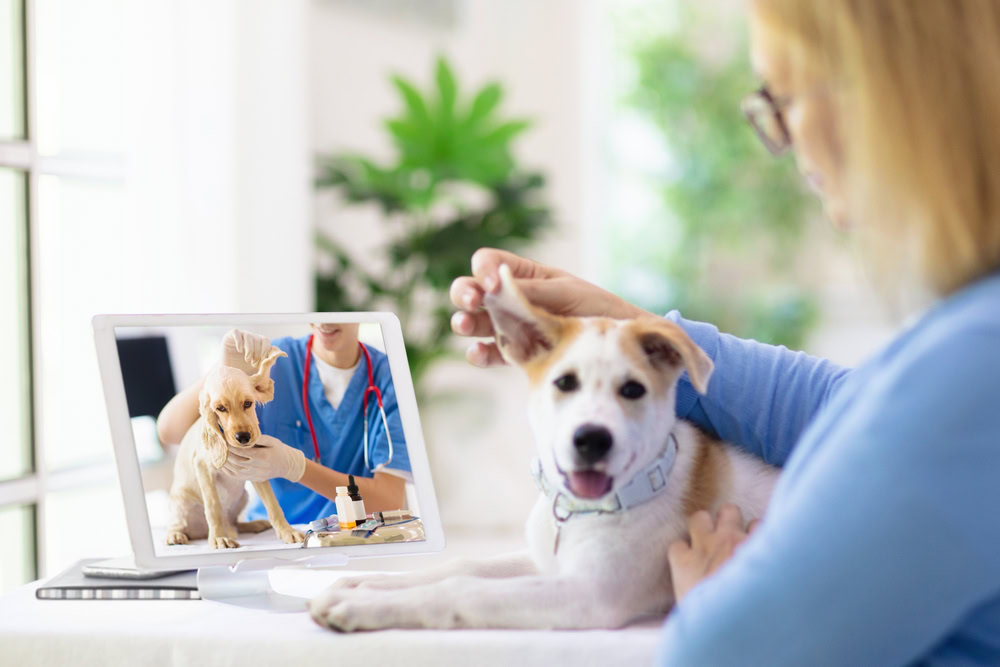
Among the many changes we have seen since Covid-19 changed life as we knew it, there has been a large increase in the number of online vet consultations available, and it’s easy to understand why. These services are convenient, generally cost less, and great for pets who aren’t too enthusiastic about car trips, giving you the chance to have an initial consultation with a vet to assess whether your pet needs to be seen in person.
With this in mind, it’s highly likely you’ll be taking part in this new online world at some point. But how do you prepare for one of these appointments? And what can you expect from a virtual consultation? In this article, we’ll help answer some of your questions.

How Does a Virtual Vet Visit Work?
Virtual vet visits, also known as remote veterinary or telemedicine consultations, are typically consultations conducted over the telephone, or, more recently, video calls. These appointments allow owners to talk with vets about their pet’s health issues or simply for guidance and advice, plus show vets images of their pet’s condition if needed. Vets can then give pet owners advice on the next steps to take.
It’s important to mention that this cannot replace a regular visit to the vet where they can physically examine pets, perform tests, and prescribe medication. These services are only suitable for non-urgent medical concerns, follow-up appointments, or conditions where an initial remote assessment may be sufficient to start on a diagnostic and treatment pathway. It’s important to always seek emergency veterinary care from your local clinic if you suspect in any way that your pet needs urgent help.

Preparation
Before your virtual vet visit, you need to make sure you’re prepared. This will save vital time during your call, and make sure you don’t forget any important information.
- Platform: The first thing you’ll need to do is decide on a platform or company. There are many available these days, so do some research to see what is on offer, the platform’s reputation, and any other information they offer. Some veterinary practices will have an associated online consulting feature, as do some pet insurance companies.
- Set up your space: In order to make the call as smooth as possible, make sure the space where you jump on the call is quiet and well-lit, and you won’t have any interruptions.
- Have your pet with you or close by: this may not always be possible, but it’s much easier to have access to your pet in case the vet wants to see or hear something, particularly in cases like a lameness, skin issue, eye problem, or a cough.
- Gather all your information: You need to make sure you have all medical records of your pet on hand, including medical history, most recent health records, and any medication they are on or have been on. If relevant, take some good quality photos of your pet’s condition (if needed)—especially if your pet will not physically be there.
What to Expect
Typically, your online vet will begin by asking a series of important questions. They need to gather as much information about your pet as they can, including any previous history of injuries or illness, and any chronic issues. During this time, you can discuss any concerns you have about your pet.
It’s vital to be completely transparent and open with the vet. This will allow the vet to make an accurate as possible diagnosis for your pet. Again, it’s a good idea to have pictures or videos on hand of the condition at hand, especially if it’s not something obvious on your pet. Of course, this is also a great opportunity to ask any questions you may have at this point.
After the Appointment
Once your appointment is over, your vet should have given you a set of clear instructions to follow pertaining to your pet. Most will even send a written report to help you make sure you’ve checked all the important boxes. It’s important to follow these instructions carefully, and book a follow-up appointment if you have any concerns or things don’t seem to be improving.
In many cases, it may be necessary to make an appointment for your pet to be seen in person, either immediately or at a later date. With pets unable to describe their symptoms, a lot of information must be obtained through feeling, listening, even smelling a problem.


What Cases Are Virtual Vet Visits Best Suited For?
While virtual vet visits are limited in many ways, including prescribing medication or doing a physical checkup, there are several cases where a virtual appointment may be ideal.
These include:
- General health-related inquiries or concerns.
- Follow-up appointments for checking up after a previous treatment.
- Any behavioral concerns.
- Assessing skin or coat issues such as rashes or wounds.
- Consultation on ideal diet and weight management.
As we mentioned earlier, any time your pet needs immediate attention for something like an illness or injury, it’s best to visit your local vet or emergency clinic.

Conclusion
Virtual vet visits are a great way to get advice and guidance from an expert, all from the comfort of your own home. It’s vital to be prepared, though, as this will help the vet on the other side give you the most valuable and pertinent guidance they can.
Hopefully, our article has helped clear up any questions you may have, and you are now ready for your first virtual appointment!
Featured Image Credit: FamVeld, Shutterstock

